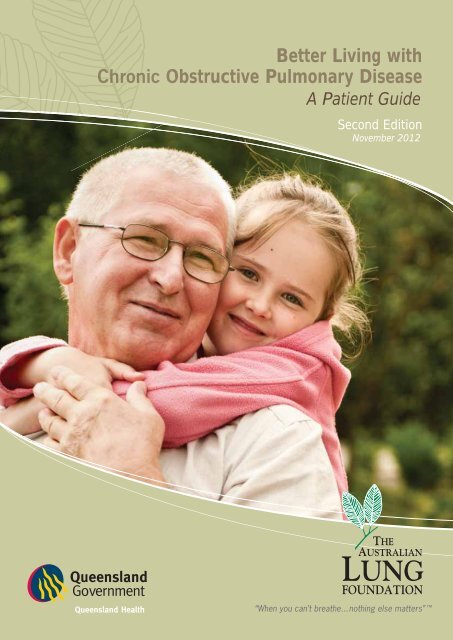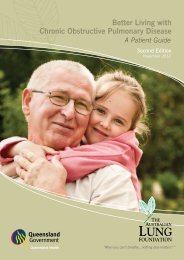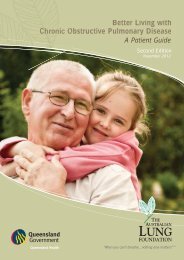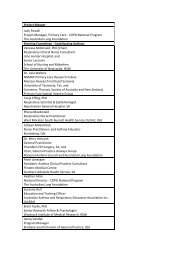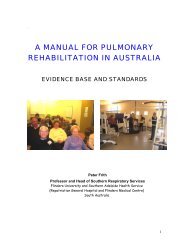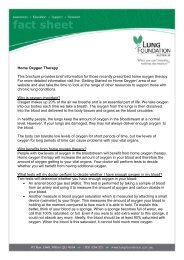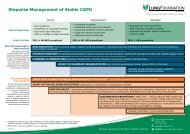Better Living with COPD - Australian Lung Foundation
Better Living with COPD - Australian Lung Foundation
Better Living with COPD - Australian Lung Foundation
Create successful ePaper yourself
Turn your PDF publications into a flip-book with our unique Google optimized e-Paper software.
<strong>Better</strong> <strong>Living</strong> <strong>with</strong> Chronic Obstructive Pulmonary Disease A Patient Guide<br />
Queensland Health<br />
<strong>Better</strong> <strong>Living</strong> <strong>with</strong><br />
Obstructive Pulmonary Disease<br />
A Patient Guide<br />
Second Edition<br />
November 2012<br />
©The State of Queensland (Queensland Health) and The <strong>Australian</strong> <strong>Lung</strong> <strong>Foundation</strong> 2012<br />
a
Chapter 5: Your role in managing your chronic obstructive pulmonary disease<br />
<strong>Better</strong> <strong>Living</strong> <strong>with</strong> Chronic Obstructive Pulmonary Disease A Patient Guide<br />
<strong>Better</strong> <strong>Living</strong> <strong>with</strong> Chronic Obstructive Pulmonary Disease A Patient Guide is a joint project of the<br />
Statewide <strong>COPD</strong> Respiratory Network, Clinical Practice Improvement Centre, Queensland Health and<br />
The <strong>Australian</strong> <strong>Lung</strong> <strong>Foundation</strong>, <strong>COPD</strong> National Program.<br />
This work is copyright and copyright ownership is shared between the State of Queensland (Queensland Health)<br />
and The <strong>Australian</strong> <strong>Lung</strong> <strong>Foundation</strong> 2012. It may be reproduced in whole or in part for study, education or<br />
clinical purposes subject to the inclusion of an acknowledgement of the source. It may not be reproduced<br />
for commercial use or sale. Reproduction for purposes other than those indicated above requires written<br />
permission from both Queensland Health and The <strong>Australian</strong> <strong>Lung</strong> <strong>Foundation</strong>.<br />
© The State of Queensland (Queensland Health) and The <strong>Australian</strong> <strong>Lung</strong> <strong>Foundation</strong> 2012.<br />
For further information contact Statewide Respiratory Clinical Network, Patient Safety and Quality Improvement<br />
Service, e-mail: PSQ@health.qld.gov.au or phone: (07) 36369505 and The <strong>Australian</strong> <strong>Lung</strong> <strong>Foundation</strong>,<br />
e-mail: enquiries@lungfoundation.com.au or phone: 1800 654 301. For permissions beyond the scope of<br />
this licence contact: Intellectual Property Offi cer, Queensland Health, email: ip_offi cer@health.qld.gov.au<br />
or phone (07) 3234 1479.<br />
To order resources or to provide feedback please email: enquiries@lungfoundation.com.au or<br />
phone 1800 654 301.<br />
Queensland Health Statewide Respiratory Clinical Network and The <strong>Australian</strong> <strong>Lung</strong> <strong>Foundation</strong>, <strong>COPD</strong><br />
National Program – <strong>Better</strong> <strong>Living</strong> <strong>with</strong> Chronic Obstructive Pulmonary Disease A Patient Guide, 2012.<br />
ISBN 978-0-9872272-0-1
<strong>Better</strong> <strong>Living</strong> <strong>with</strong> Chronic Obstructive Pulmonary Disease A Patient Guide<br />
chapter<br />
Preventing and managing a fl are up<br />
This chapter will help you to understand:<br />
What an exacerbation or fl are up is.<br />
How to monitor your symptoms and avoid having a fl are up.<br />
What to do when you become sick.<br />
How to develop and use a written <strong>COPD</strong> Action Plan to manage a fl are up.<br />
What is an exacerbation or fl are up?<br />
All people <strong>with</strong> chronic obstructive pulmonary disease<br />
(<strong>COPD</strong>) are at risk of having an exacerbation or<br />
fl are up.<br />
A fl are up is what happens when your <strong>COPD</strong> gets<br />
worse. Flare ups can become serious and you may<br />
even need to go to hospital. It is important for you to<br />
understand how to avoid having a fl are up, what the<br />
signs and symptoms of a fl are up are, and how you<br />
can minimise their impact.<br />
Some of the typical signs and symptoms of a fl are<br />
up are one or more of the following:<br />
More wheezy or breathless than usual.<br />
More coughing.<br />
More sputum than usual.<br />
A change of colour in your sputum.<br />
Loss of appetite or sleep.<br />
Less energy for your usual activities.<br />
Taking more of your reliever medication<br />
than normal.<br />
<strong>COPD</strong> Action Plans aim to help you recognise<br />
a fl are up earlier and provide instructions on<br />
how to act to reduce the severity and duration<br />
of your illness.<br />
How can you monitor your symptoms<br />
and avoid having a fl are up?<br />
There are several possible triggers that can cause a<br />
fl are up. Some people are particularly susceptible to<br />
certain ones. These triggers include:<br />
Respiratory infections, such as a cold or the fl u.<br />
Smoke.<br />
Pollutants such as dust, wood smoke or smog.<br />
Other unknown causes account for about one<br />
third of all fl are ups.<br />
There are things you can do to avoid getting a fl are up:<br />
Develop a written <strong>COPD</strong> Action Plan <strong>with</strong> your<br />
doctor and know how to use it (see page 38).<br />
Learn what the triggers are that make your<br />
<strong>COPD</strong> worse and how to avoid them.<br />
• Stay inside on particularly cold or hot days<br />
if possible.<br />
• Avoid second hand smoke.<br />
• Avoid strong cleaning products or<br />
strong perfume.<br />
Make sure you get the fl u vaccination<br />
every autumn.<br />
Make sure that you are vaccinated to protect<br />
you from pneumonia (see page 93 for details).<br />
Take your medications regularly and as<br />
prescribed by your doctor.<br />
©The State of Queensland (Queensland Health) and The <strong>Australian</strong> <strong>Lung</strong> <strong>Foundation</strong> 2012<br />
9<br />
36
37<br />
<strong>COPD</strong> Symptom Diary<br />
The common symptoms of <strong>COPD</strong> are shortness of breath, persistent cough, coughing up sputum, and wheezing. Use this diary to track your symptoms on a daily basis.<br />
Take this table when you go to visit your doctor. This will help to manage your <strong>COPD</strong>.<br />
Comments<br />
When?<br />
(day, night, at rest?)<br />
<strong>Better</strong> / worse / more<br />
frequent then normal?<br />
How often?<br />
(3 times a day)<br />
Symptoms<br />
(shortness of breath, persistent cough,<br />
coughing up sputum, wheezing)<br />
Date<br />
21/03/12 Shortness of breath 4 times a day Worse than normal All of the above I am not usually breathless.<br />
Example<br />
Chapter 9: Preventing and managing a fl are up<br />
<strong>Better</strong> <strong>Living</strong> <strong>with</strong> Chronic Obstructive Pulmonary Disease A Patient Guide
<strong>Better</strong> <strong>Living</strong> <strong>with</strong> Chronic Obstructive Pulmonary Disease A Patient Guide<br />
Maintain good hand hygiene.<br />
Avoid people <strong>with</strong> colds and fl u.<br />
Take good care of yourself by eating healthy<br />
foods, exercising and getting enough sleep.<br />
Keep track of your daily symptoms so that you<br />
can recognise quickly when you are starting to<br />
become unwell (a sample symptom diary is<br />
provided on page 37).<br />
The sample symptom diary captures information<br />
about your symptoms such as cough, sputum and<br />
shortness of breath. Some people fi nd a diary like<br />
this one helps them to recognise when their<br />
symptoms change.<br />
What can you do when you become sick?<br />
When you start to become sick it is important that<br />
you act quickly. The quicker you act, the less likely<br />
it is that you will end up in hospital.<br />
Follow the instructions on your written <strong>COPD</strong><br />
Action Plan (see page 39).<br />
Reduce your activity level.<br />
Clear sputum <strong>with</strong> the cough and huff<br />
technique (see page 59).<br />
Practice controlled breathing and relaxation<br />
techniques (see page 54).<br />
Eat small amounts of nourishing food.<br />
Drink extra fl uids.<br />
Use additional medication as planned by<br />
your doctor.<br />
Contact your doctor if fl are up becomes severe.<br />
How can you develop and use a written<br />
<strong>COPD</strong> Action Plan<br />
To be successful it is essential that you plan it together<br />
<strong>with</strong> your doctor. Nursing and allied health staff can<br />
start the development of the plan, however decisions<br />
about medication changes must be made by a doctor<br />
or an appropriately qualifi ed nurse practitioner.<br />
<strong>COPD</strong> Action Plans work best when they are checked,<br />
updated and reinforced regularly. This should occur<br />
each six months or after each fl are up.<br />
Step 1<br />
Talk to your doctor about developing a <strong>COPD</strong> Action<br />
Plan. When developing the plan <strong>with</strong> your doctor,<br />
you will discuss what happened <strong>with</strong> previous fl are<br />
ups. You will need to identify the lead up signs and<br />
symptoms you experienced (consider the events that<br />
were both associated and not associated <strong>with</strong> an<br />
infection), the treatment and outcomes. Check your<br />
Symptom Diary for information.<br />
Step 2<br />
You and your doctor will then agree on what actions<br />
you should take to manage your <strong>COPD</strong> whilst you<br />
are stable but also during a moderate fl are up and<br />
a severe fl are up.<br />
Your stable section will include your “usual daily<br />
medication” and may include other information<br />
about your care, i.e. contact details for your doctor,<br />
oxygen use and lung function readings.<br />
Step 3<br />
Mild to moderate fl are up “What to do when unwell/<br />
having a moderate attack”.<br />
You and your doctor agree on treatment directions<br />
for management of a moderate fl are up. This will<br />
include details about increasing your reliever dose,<br />
the frequency and the delivery method. You may also<br />
get directions on starting a course of steroid tablets<br />
and / or an antibiotic if signs of an infection are present.<br />
You and your doctor will then agree on the point that<br />
you will need to seek urgent medical treatment in<br />
the case your fl are up becomes severe. It will be<br />
extremely important to recognise when to seek urgent<br />
treatment and what you can do whilst waiting for<br />
help to arrive. Your Action Plan will provide you <strong>with</strong><br />
these instructions.<br />
Step 4<br />
Your doctor will need to provide or arrange for<br />
prescriptions for extra medications to use <strong>with</strong> the<br />
<strong>COPD</strong> Action Plan (eg. steroid tablets or antibiotics<br />
to keep at home <strong>with</strong> your <strong>COPD</strong> Action Plan).<br />
Step 5<br />
Don’t forget to get your doctor to sign and date<br />
the plan to ensure it is up to date.<br />
Step 6<br />
Ask your doctor, nurse or health care person to<br />
explain the <strong>COPD</strong> Action Plan to you and to your<br />
carer regularly including all the signs to watch for<br />
and actions to take.<br />
Step 7<br />
Keep your plan somewhere visible at home (on<br />
the fridge). Remember to always bring your <strong>COPD</strong><br />
Action Plan to your clinic, doctor appointments<br />
and admissions to hospital.<br />
©The State of Queensland (Queensland Health) and The <strong>Australian</strong> <strong>Lung</strong> <strong>Foundation</strong> 2012<br />
38
39<br />
There are several types of Action Plans for <strong>COPD</strong>.<br />
We provide two of these below. It doesn’t really matter<br />
which Action Plan you use. It is just important that<br />
you use one!<br />
A copy of the Queensland Health <strong>COPD</strong> Action Plan<br />
can be downloaded from the following website:<br />
www.health.qld.gov.au/psq/Networks/docs/<br />
srcn-copd-actpln.pdf<br />
<strong>COPD</strong> Action Plan<br />
<br />
<br />
» What <strong>COPD</strong> is and how your lungs work<br />
» How much you can usually do<br />
» Your usual appetite and sleep pattern<br />
<br />
» Avoid cigarette smoke<br />
» Get vaccinated<br />
» <br />
» Join a support group<br />
» <br />
» Attend rehab<br />
( (use se w<strong>with</strong><br />
correct technique)<br />
» Your usual level of breathlessness and cough<br />
» Colour and amount of mucus you cough up<br />
» Treatment options for severe exacerbations<br />
» <br />
» Join a walk group<br />
» Learn to control your breathing and cough<br />
» Use medications and oxygen as prescribed<br />
» Plan your activities and pace yourself<br />
» Keep in touch <strong>with</strong> friends<br />
Quick reliever: ................................................................... mcg, ..................... puffs / nebule, ..................... times a day and as needed.<br />
Slow reliever: .............................................................................................................. mcg, ..................... puffs / nebule / capsule, ..................... a day.<br />
Preventer / combination: .................................................................................................................. mcg, ..................... puffs, ..................... times a day.<br />
<br />
Use at least ................ hours a day, day, on on ................. ................. LPM. LPM. With With exercise, exercise, use use ................. ................. LPM. LPM. When When sleeping, sleeping, ................. ................. LPM. LPM.<br />
<br />
<br />
General Practitioner (GP): Phone: Phone:<br />
Specialist: Phone: Phone:<br />
<strong>Australian</strong> <strong>Lung</strong> <strong>Foundation</strong> undation (ALF) (ALF)<br />
Phone: Phone:<br />
1800 1800 654 654 301 301<br />
Other: Phone: Phone:<br />
“<strong>Better</strong> <strong>Living</strong> <strong>with</strong> <strong>COPD</strong> <strong>COPD</strong> - A Patient Patient Guide” Guide”<br />
” <br />
<br />
FEV1 FVC<br />
SpO2 / FiO2<br />
Weight<br />
<br />
URN:<br />
Family name:<br />
Given name(s):<br />
Address:<br />
Date of birth: Sex: M F I<br />
(use <strong>with</strong> ith ith h cor cor correct rect rect ect tt te te technique chnique chnique chnique iq<br />
)<br />
<br />
<strong>COPD</strong> Action Plan<br />
URN:<br />
Family name:<br />
Given name(s):<br />
Address:<br />
Facility: ......................................................................................................... Date of birth: Sex: M F I<br />
(if you have 2 or more signs in bold <strong>with</strong> a *, antibiotics are usually needed)<br />
................................ mcg, ..................... puffs / nebule, ..................... times a day and as needed.<br />
........................................................................ mcg, ..................... puffs / nebule / capsule, ..................... a day.<br />
.............................................................................................................. mcg, ..................... puffs, ..................... times a day.<br />
<br />
» * » Tiredness<br />
» Coughing<br />
» *<br />
» Use of reliever<br />
» *<br />
Date: Date: Date: Date: Date:<br />
Value % Pred Pred Value Value % Pred Pred Value Value % Pred Pred<br />
Completed by (print name): Designation: Designation: Signature: Signature: Date: Date:<br />
<br />
<br />
Page 2 of 2<br />
DO NOT WRITE IN THIS BINDING MARGIN<br />
» *<br />
<br />
» Lack of appetite<br />
<br />
1 Start these extra medications:<br />
Increase reliever: ..................................................................................... Take ................... puffs / nebule, up to every ................... hours.<br />
Prednisolone: Take ..................... tablets ( .................... mg), daily <strong>with</strong> food for .................... days, then stop / reduce.<br />
....................................................................................................................................................................................................................................................................................................<br />
Antibiotic: ........................................................................................................ ( ................... mg). Take ................... tablets ................... times a day.<br />
........................................................................................................ ( ................... mg). Take ................... tablets ................... times a day.<br />
Allergies / alerts: ...............................................................................................................................................................................................................................................<br />
2 Call your GP for an appointment. Phone: ..............................................................................................<br />
Also call your respiratory nurse Phone: ..............................................................................................<br />
3 <br />
4 Clear the mucus from your lungs regularly.<br />
5 Reduce activity and rest often. Resume usual exercise as you improve.<br />
<br />
Print name: Signature: Date:<br />
<br />
Print name: Designation: Signature: Date:<br />
<br />
<br />
» <br />
» <br />
Queensland Health<br />
<strong>COPD</strong> Action Plan<br />
» <br />
» <br />
» <br />
» <br />
<strong>Better</strong> <strong>Living</strong> <strong>with</strong> Chronic Obstructive Pulmonary Disease A Patient Guide<br />
» <br />
Phone an ambulance (000) immediately. Show this plan to the Paramedics.<br />
CO2 Retainer Yes No Please keep SaO2 88–92%<br />
Patient signature: Date:<br />
Chapter 9: Preventing and managing a fl are up<br />
A copy of The <strong>Australian</strong> <strong>Lung</strong> <strong>Foundation</strong> ‘<strong>COPD</strong> Action<br />
Plan’ can be downloaded from the following website:<br />
www.lungfoundation.com.au and look under Professional<br />
Resources or can be obtained by calling 1800 654 301.<br />
The <strong>Australian</strong> <strong>Lung</strong> <strong>Foundation</strong><br />
<strong>COPD</strong> Action Plan


